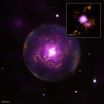(Press-News.org) WASHINGTON (Nov. 15, 2012) – Researchers at the George Washington University School of Medicine and Health Sciences (SMHS) will be featured as a top paper in next week's issue of the Journal of Biological Chemistry. Research by Rakesh Kumar, Ph.D., Catharine Birch McCormick Endowed Chair of the Department of Biochemistry and Molecular Biology and professor of biochemistry and molecular biology, and Beatriz Sánchez-Solana, postdoctoral fellow at the department of biochemistry and molecular medicine, both at SMHS, has been selected as the journal's "Paper of the Week". The study, titled "p21-activated Kinase-1 Signaling Regulates Transcription of Tissue Factor and Tissue Factor Pathway Inhibitor," was chosen for its groundbreaking discovery of a new regulator of the blood coagulation cascade.
The research will be featured starting on Nov. 16, in Volume 287, No. 47 of the journal. The journal's editorial board members and associate editors determined the paper to be in the top two percent of manuscripts they will review in a year in significance and overall importance. About 50 to 100 papers are selected from the more than 6,600 published in the journal each year. The research will also be featured as the issue's cover image.
Blood coagulation, which many are aware of in terms of blood clotting after cuts and injuries, is a continuous process in the blood. It is a dynamic process, and there is a need to prevent and promote coagulation from time to time, for example, in the control of some diseases related to coagulation, such as cancer. As a whole, coagulation is regulated and initiated by a protein, named Tissue Factor (TF). TF works with many other proteins in a series of chain reactions in order to create coagulation. The activity of TF, a positive regulator of coagulation, is controlled by tissue factor pathway inhibitor (TFPI), a negative regulator, creating a balanced state.
"What was not known in the field is if there was any shared regulator or shared pathway, which cannot only regulate a positive regulator, but could also regulate a negative regulator of coagulation," said Kumar. "This is what we have found."
"We discovered for the first time that PAK1 [p21-activated Kinase-1] was implicated both in the regulation of the expression of TF, as well as TFPI," said Sánchez-Solana.
P21-activated Kinase-1 (PAK1) has been widely implicated in cancer. There are many cancers where the expression of TF is up-regulated and outside research to support the idea that increasing expression of TF or a deregulated coagulation could contribute to cancer progression. The discovery made by Kumar and Sánchez-Solana states that PAK1 is able to induce the expression of TF, but at the same time repress the expression of TFPI, promoting a hypercoagulant state. This is important not only to coagulation, but also coagulation as implicated in many cancers and diseases. By controlling the expression or activity of PAK1, which has been shown in this study to control coagulation, it can be used as a therapy for these coagulation processes.
"Should these findings be verified in animals, our research suggests it should be possible to change the rate of coagulation or the process of coagulation outcome by interfering or effecting the PAK1 signaling," said Kumar.
###
The Journal of Biological Chemistry is a prestigious journal of the American Society for Biochemistry and Molecular Biology, in publication since 1905. The journal publishes papers based on original research that are judged to make a novel and important contribution to understanding the molecular and cellular basis of biological processes.
The "Paper of the Week" will be announced and highlighted at http://www.jbc.org/ and http://www.jbc.org/potw. To interview Dr. Kumar or Dr. Sánchez-Solana, please contact Lisa Anderson, lisama2@gwu.edu, 202-994-3121.
About the School of Medicine and Health Sciences
Founded in 1825, the GW School of Medicine and Health Sciences (SMHS) was the first medical school in the nation's capital and is the 11th oldest in the country. Working together in our nation's capital, with integrity and resolve, the GW SMHS is committed to improving the health and well-being of our local, national and global communities. www.smhs.gwumc.edu. END
GW Research chosen as 'paper of the week' for blood coagulation discovery
2012-11-15
ELSE PRESS RELEASES FROM THIS DATE:
President's Bioethics Commission posts Study Guide
2012-11-15
Washington, D.C. – The Presidential Commission for the Study of Bioethical Issues today released an ethics study guide based on the Commission's investigation into the U.S. Public Health Service (PHS) experiments conducted in Guatemala in the 1940s. A Study Guide to "Ethically Impossible" STD Research in Guatemala from 1946 to 1948 is designed for use by higher education and other interested members of the public. It is free and available for immediate use in classrooms and elsewhere at www.bioethics.gov.
"As the world is now aware, the PHS research involved intentionally ...
ACA: More than a million women could gain access to potentially life saving tests for cancer
2012-11-15
WASHINGTON—A study by researchers at the George Washington University School of Public Health and Health Services (SPHHS) indicates that full implementation of the Affordable Care Act would expand health insurance coverage for more low-income women, enabling more than a million women to obtain potentially life-saving screening for breast and cervical cancer. The study, "Health Care Reform and Women's Insurance Coverage for Breast and Cervical Cancer Screening," was published in a recent issue of the journal Preventing Chronic Disease.
In the past, many low income women ...
Protein tug of war points toward better therapies for cardiovascular disease
2012-11-15
AUGUSTA, Ga. – Two proteins are in a tug of war that determines how much the body makes of superoxide, a highly reactive and potentially destructive product of oxygen that's dramatically elevated in cardiovascular disease, researchers report.
Their finding indicates an antiulcer drug just may help the body reduce excessive levels.
Hsp90 and Hsp70 are both heat shock proteins but appear to have opposite effects on reactive oxygen species production, said Dr. David J.R. Fulton, Interim Director of the Vascular Biology Center at the Medical College of Georgia at Georgia ...
Researchers uncover some good news for BC's troubled salmon populations
2012-11-15
Researchers uncover some good news for BC's troubled salmon populations
A University of Alberta led research team has some positive news for British Columbia's pink salmon populations, and the salmon farming industry that has struggled to protect both captive and wild salmon from sea lice infestations.
There has long been concern that concentrations of sea lice in BC's fish farming pens spread to wild fish stock in surrounding waters.
The researchers discovered that by changing the timing of sea lice treatments, one salmon farming region not only improved the health ...
Researchers use GPS tracking to monitor crab behavior
2012-11-15
This press release is available in German.
Researchers from Jena and Greifswald used GPS satellites for a long-term behavioral monitoring of land crab migration on Christmas Island. In cooperation with colleagues from the Zoological Institute at the University of Greifswald, scientists from the Max Planck Institute for Chemical Ecology in Jena, Germany, used a GPS-based telemetric system to analyze movements of freely roaming robber crabs, which is the first large-scale study of any arthropod using GPS technology to monitor behavior.
This analysis focussed on the ...
Born-again star foreshadows fate of solar system
2012-11-15
Astronomers have found evidence for a dying Sun-like star coming briefly back to life after casting its gassy shells out into space, mimicking the possible fate our own Solar System faces in a few billion years.
This new picture of the planetary nebula Abell 30, located 5500 light-years from Earth, is a composite of visible images from the NASA/ESA Hubble Space Telescope and X-ray data from ESA's XMM-Newton and NASA's Chandra space telescopes.
'Planetary nebula' is the name given to the often-concentric shells of stellar material cast into space by dying stars. To astronomers ...
X-rays from a reborn planetary nebula
2012-11-15
These images of the planetary nebula Abell 30, (a.k.a. A30), show one of the clearest views ever obtained of a special phase of evolution for these objects. The inset image on the right is a close-up view of A30 showing X-ray data from NASA's Chandra X-ray Observatory in purple and Hubble Space Telescope (HST) data showing optical emission from oxygen ions in orange. On the left is a larger view showing optical and X-ray data from the Kitt Peak National Observatory and ESA's XMM-Newton, respectively. In this image the optical data show emission from oxygen (orange) and ...
Streams show signs of degradation at earliest stages of urban development
2012-11-15
The loss of sensitive species in streams begins to occur at the initial stages of urban development, according to a new study by the USGS. The study found that streams are more sensitive to development than previously understood.
"We tend not to think of waterways as fragile organisms, and yet that is exactly what the results of this scientific investigation appear to be telling us," said USGS Director Marcia McNutt. "Streams are more than water, but rather communities of interdependent aquatic life, the most sensitive of which are easily disrupted by urbanization."
Contaminants, ...
Umbilical cord cells outperform bone marrow cells in repairing damaged hearts
2012-11-15
TORONTO, Ontario (13 November, 2012) - A study published this month by researchers at the University of Toronto and Toronto's Princess Margaret Hospital has shown that cells derived from the umbilical cord, "Human Umbilical Cord PeriVascular Cells" (HUCPVCs), are more effective in restoring heart function after an acute myocardial infarction (in common parlance, a heart attack) in a pre-clinical model than a similar cell population derived from bone marrow.
At present, mesenchymal cells, known to release a series of factors that stimulate tissue repair, and control inflammation, ...
Study Tracks Brain Gene Response to Territorial Aggression
2012-11-15
CHAMPAIGN, Ill. — With a mate and a nest to protect, the male threespined stickleback is a fierce fish, chasing and biting other males until they go away.
Now researchers are mapping the genetic underpinnings of the stickleback's aggressive behavior. Armed with tools that allow them to see which genes are activated or deactivated in response to social encounters, a team from the University of Illinois has identified broad patterns of gene activity that correspond to aggression in this fish.
A paper describing their work appears in the Proceedings of the Royal Society: ...




